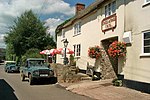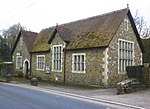Dalwood

Dalwood is a village and county parish in the East Devon district of the English county of Devon. It is approximately 3 miles (4.8 km) away from the nearest town, Axminster, and 5 miles (8.0 km) away from Honiton. Dalwood can be accessed by the nearby A35 road. The village is placed within the Blackdown Hills Area of Outstanding Natural Beauty. Along with the nearby village of Stockland, until 1842 the village was a part of an outlier of the county of Dorset. Dalwood is a small village with a church, a primary school, village hall and public house. St Peter's church is 15th century and was restored in 1881. It has some early stained glass windows. Immediately to the right of the main door (and partly visible in photograph) is the grave of Pedro de Alcantara Travassos Valdez, a son of the Portuguese soldier and Prime Minister José Lucio Travassos Valdez, 1st Count of Bonfim.Nearby Loughwood Meeting House just north of the A35 road is an 18th-century Baptist chapel with an unaltered interior. Some landscaped gardens are opened to the public at nearby Burrow Farm.Home to the 800 year old thatched English Inn with original inglenook fireplace and flagstone floors, the tuckers arms are now esteemed for great food and hospitality
Excerpt from the Wikipedia article Dalwood (License: CC BY-SA 3.0, Authors, Images).Dalwood
Dalwood Lane, East Devon
Geographical coordinates (GPS) Address Nearby Places Show on map
Geographical coordinates (GPS)
| Latitude | Longitude |
|---|---|
| N 50.799068 ° | E -3.066492 ° |
Address
Hutchins Barton
Dalwood Lane
EX13 7HU East Devon
England, United Kingdom
Open on Google Maps










